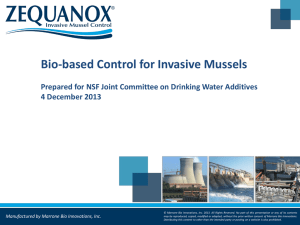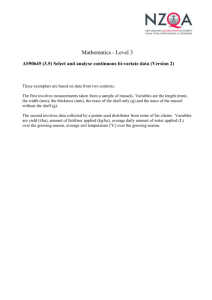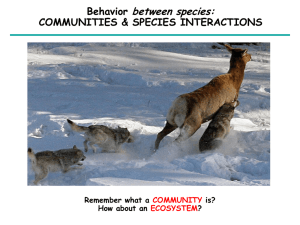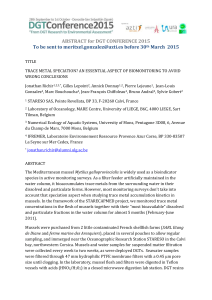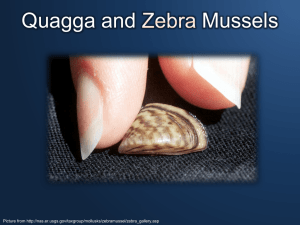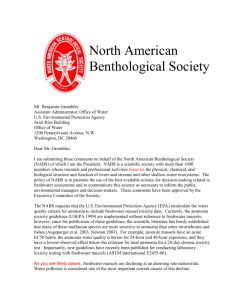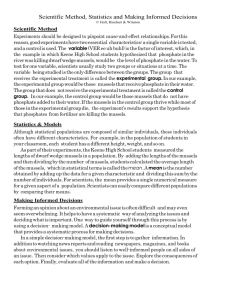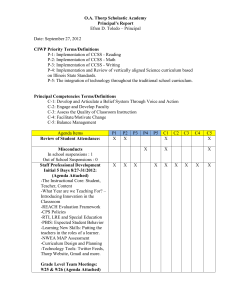Duval_native_mussels - BIOEEOS660-f12
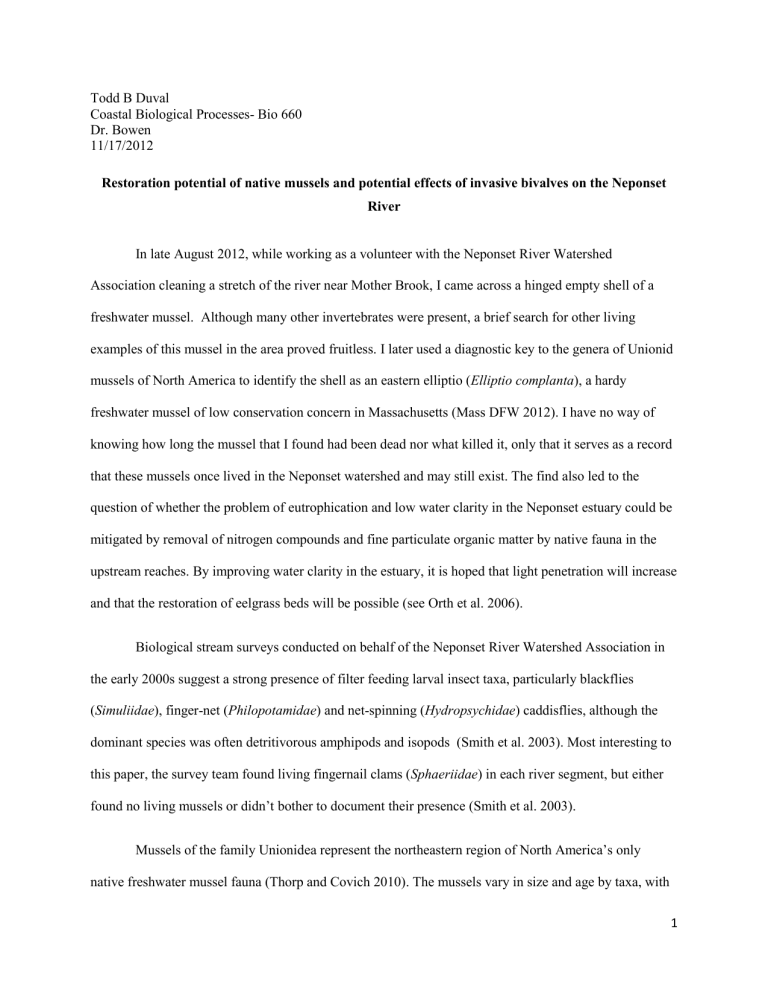
Todd B Duval
Coastal Biological Processes- Bio 660
Dr. Bowen
11/17/2012
Restoration potential of native mussels and potential effects of invasive bivalves on the Neponset
River
In late August 2012, while working as a volunteer with the Neponset River Watershed
Association cleaning a stretch of the river near Mother Brook, I came across a hinged empty shell of a freshwater mussel. Although many other invertebrates were present, a brief search for other living examples of this mussel in the area proved fruitless. I later used a diagnostic key to the genera of Unionid mussels of North America to identify the shell as an eastern elliptio ( Elliptio complanta ), a hardy freshwater mussel of low conservation concern in Massachusetts (Mass DFW 2012). I have no way of knowing how long the mussel that I found had been dead nor what killed it, only that it serves as a record that these mussels once lived in the Neponset watershed and may still exist. The find also led to the question of whether the problem of eutrophication and low water clarity in the Neponset estuary could be mitigated by removal of nitrogen compounds and fine particulate organic matter by native fauna in the upstream reaches. By improving water clarity in the estuary, it is hoped that light penetration will increase and that the restoration of eelgrass beds will be possible (see Orth et al. 2006).
Biological stream surveys conducted on behalf of the Neponset River Watershed Association in the early 2000s suggest a strong presence of filter feeding larval insect taxa, particularly blackflies
( Simuliidae ), finger-net ( Philopotamidae ) and net-spinning ( Hydropsychidae ) caddisflies, although the dominant species was often detritivorous amphipods and isopods (Smith et al. 2003). Most interesting to this paper, the survey team found living fingernail clams ( Sphaeriidae ) in each river segment, but either found no living mussels or didn’t bother to document their presence (Smith et al. 2003).
Mussels of the family Unionidea represent the northeastern region of North America’s only native freshwater mussel fauna (Thorp and Covich 2010). The mussels vary in size and age by taxa, with
1
a range of 3 to 30 cm shell width (Williams et al. 1993, Thorp and Covich 2010) and ages from 10 years to over 30 years (Crabtree and Smith 2009, Singer and Gangloff 2011). These suspension-feeding and planktivorous animals are widely distributed throughout the world with the highest diversity of species occurring in North America (Pennak 1989, Thorp and Covich 2010). Watersheds in the southeastern
United States have been ranked as a mussel biodiversity hotspot by the Nature Conservancy for many years (Williams et al. 1993). Historically abundant, freshwater mussels served as a food source and decorative item for many indigenous North Americans (Pennak 1989, Williams et al. 1993). These mussels were also important in the manufacture of mother-of-pearl buttons for clothing fasteners until the invention of plastics in the mid-20 th century, a thriving industry that led to population declines in many areas (Pennak 1989, Williams et al. 1993, Strayer 2006, Thorp and Covich 2010). Industrial harvesting continues for some species in western states, to feed Asian seed-pearl markets for the cultivation of freshwater pearls (Thorp and Covich 2010).
The greatest abundance of freshwater mussel species can be found in larger river reaches (Pennak
1989), although some species can persist in smaller streams by burrowing into the hyporheic zone during low-flow periods (Nicklen and Balas 2007, Singer and Gangloff 2011). Because I conducted my quick survey for mussels in the Neponset during low-flow August conditions, this burrowing behavior might be the reason that I could not find living mussels. It is suggested that the best mussel habitat can be found where the stream substrate is heterogeneous, with a mix of exposed cobble and boulders surrounded by fine sediments and a range of stream velocities and less than 50% embeddedness of substrates (Nicklen and Balas 2007). As listed in Smith et al. 2003, these microhabitats certainly exist in some stretches of the
Neponset, and it is in these areas that any potential new mussel survey should be conducted. There are several small impoundments in the Neponset, which can have a positive effect on mussel growth (Singer and Gangloff 2011) at the expense of dispersal (Pennak 1989, Williams et al. 1993, Ricciardi and
Rasmussen 1999, Layzer and Scott 2006, Thorp and Covich 2010).
2
Several important ecosystem functions can be attributed to the Unionids. Burrowing movements of these mussels create hydrologic conditions that accelerate sediment deposition and their biological activity can return nutrients to the benthic community (Nicklen and Balas 2007, Thorp and Covich 2010).
Most importantly to the eelgrass restoration goal, they increase water clarity by ingestion of fine particulate organic matter (FPOM) and phytoplankton cells (Pennak 1989, Williams et al. 1993, Strayer
2006, Nicklen and Balas 2007, Thorp and Covich 2010). Clearance rates differ between species and age, with older, larger individuals having less efficient feeding, but can be generalized at 1 to 2 liters per hour per gram of ash-free dry mass (AFDM) of mussel wet tissue, the average AFDM of unionids nearing ~5 g
(Thorp and Covich 2010). With densities that range from 0.006 to 2.327 mussels per m 2 in unimpacted streams (Crabtree and Smith 2009), this gives us a range of clearance rates of ~0.03 l/m 2 /hr at the lowest density and rate to ~23.27 l/m 2 /hr under the most favorable conditions, rates and densities. But the problem of eutrophication in the Neponset is probably not caused by an influx of upstream phytoplankton cells, rather by an influx of excess nutrients from upstream areas feeding phytoplankton blooms in the estuary. Native mussel enhancement may not return significant reductions in upstream water quality to help with this task.
Native mussels suffer the indignation of being the most imperiled group of organisms in North
America (Williams et al, 1993, Ricciardi and Rasmussen 1999, Layzer and Scott 2006, Regnier et al.
2009, Crabtree and Smith 2009). With 83 extinctions among the 297 species described in the U.S., some of these mollusks now appear on the Red List of the International Union for the Conservation of Nature
(IUCN), with 55% of remaining North American species listed as imperiled by the Nature Conservancy
(Williams et al. 1993, Regnier et al. 2009). Ricciardi and Rasmussen (1999) suggest that a further 127 species will become extinct by 2099, a ~6% loss of species per decade. Most of these extinctions and imperilments are directly caused by the familiar group of symptoms in lotic systems: pollutants, sedimentation, damming and land-use changes (Ricciardi and Rasmussen 1999, Layzer and Scott 2006,
Regnier et al. 2009, Crabtree and Smith 2009, Thorp and Covich 2010). Changes in lotic systems that
3
result in high temperature swings and periodic anoxic conditions, such as the conditions below large regulated hydroelectric and flood-control dams are also correlated with the reduced density or absence of unionids (Nicklen and Balas 2007). In addition, much of the decline in unionid populations in North
America’s Ohio and Mississippi river drainages can be attributed to out-competition for habitat and planktonic resources by Dreissenid mussels (Layzer and Scott 2006).
Unionids appear to be most affected in several ways that are relevant to the Neponset: increased stress from low-level chronic toxic metal contamination (Cd in particular), water level and temperature regimes, and habitat fragmentation that disturbs the delicate balance between the larval mussels and their obligate fish hosts (Thorp and Covich 2010).
Many unionids have unique processes for their dispersal. Much like delicate orchids which rely on a particular pollinator species, these mussels have developed secondary sexual characteristics that attract fish, in some cases specific fish species, to aid in their reproductive efforts. Male mussels will release sperm into the water column, some of which is picked up by females of the species (Thorp and
Covich 2010). The females will allow their gametes to mix with the sperm internally and hold the developing mussel larvae (glochidia) in a marsupial pouch for further development (Thorp and Covich
2010).When the glochidia are sufficiently developed in the marsupium, the female mussel will extend projections of its mantle into the water column; these projections wiggle in the water flow and resemble small fish, often with eyespots and other arrangements (Thorp and Covich 2010). When a passing fish is enticed to investigate this small “fish”, the female mussel ejects the glochidia into the face of the fish, where many pass through the mouth and settle in the gill filaments (Thorp and Covich 2010). These glochidia have several morphological adaptations for attachment to gill filaments, dependent on species; some attach by byssal threads, some clamp onto tissue with small shell lip projections (Thorp and Covich
2010). Similarly, some species’ glochidia have adapted to parasitize the host for sustenance, some have not (Thorp and Covich 2010). After a period of larval development, in which the host fish may travel up
4
to 75km (Kappes and Haase 2012), the glochidia will drop off the host and settle into the interstitial sediment zone to begin development into adults (Thorp and Covich 2010).
This unique stage in the unionid life-cycle is a key to any restoration effort. Natural repopulation in fragmented systems is not possible, although natural isolated populations may persist in a fragmented state (Layzer and Scott 2006). Mussel fauna have been successfully reared in hatchery ponds in states of the western U.S. for many years, beginning with the concern of the supply to the button industry but currently for the restoration of natural streams (Thorp and Covich 2010). Although these restoration efforts by individual state agencies may be laudable, there appears to be a lack of scientific effort to boost these programs, with scientific papers about unionids garnering about ~1% the attention paid to endemic fish species (Strayer 2006). Compounding the problem, there is a lack of funding available, with only a paltry ~$24,000 per species allotted to even the most endangered freshwater macroinvertebrates over their entire range (Strayer 2006). Currently, three species of unionids native to Massachusetts are listed as threatened and three are extinct (MA DFW 2012). These threatened mussels have recommended conservation plans, but I could find no information of current restoration projects in the state. Certainly, any restoration effort would not begin in the Neponset River, as the stream is likely too degraded by human development and suffers from summertime low-flow conditions caused by groundwater withdrawals from upstream communities (Smith et al. 2003). Compounding the problem of restoration is the presence of muskrats upstream of the Lower Mills dam near the Central Avenue bridge (author’s pers.obs.), which are a major predator of unionid mussels (Pennak 1989). Restoration funding for unionid mussels would likely be better spent in other, less degraded watersheds.
In 1988, invasive Dreissenid zebra mussels were first found in Lake St. Clair, near Detroit
(Williams et al. 1993). By 1991, they had spread to all five Great Lakes (Williams et al. 1993). These remarkably successful organisms had likely been introduced through ballast water in transoceanic shipping (Chase and Bailey 1999). By the late 2000s, these invaders had changed the entire biogeochemical cycle in the Lower Great Lakes, increasing water clarity in the notoriously culturally
5
eutrophied systems, changing substrates in nearshore areas and slowing water infiltration and groundwater recharge (Sousa et al. 2009).
Dreissenid mussels owe their rapid spread to high reproductive rates, broadcast spawning and the production of planktonic veliger larval stages, which spread rapidly through lentic systems but somewhat slower when moving into lotic systems (Thorp and Covich 2010, Kappes and Haase 2012). The dispersal of Dreissenid veliger larva often assisted by human activity, most often by recreational boater activity which can increase the natural dispersal rate 1000-fold (Kappes and Haase 2012). There is no proven method to halt this high dispersal, current methods rely on ballast water controls, bait transfers and recreational boater education (Kappes and Haase 2012, MA DFW 2012). By 2009, Dreissenid mussels were found to have spread to Laurel Lake and the Housatonic drainage in western Massachusetts (see
Figure 1, USGS 2012; MA DFW 2012).
There are two species of invasive Dreissenids in the United States: the zebra mussel ( Dreisenna polymorpha ), which colonizes hard substrates and the quagga mussel ( D. rostriformis bugensis ), which can attach to soft substrates (Chase and Bailey 1999). This combination of habitat exploitation ensures that Dreissenid colonies can spread onto most aquatic substrates.
Although individual mussels have low clearance rates of 60-70ml/hr and small sizes of 0.12g
AFDM, the mussels form dense colonies of up to 2.6 x 10 5 individuals/m 2 which can clear up to 132 m 3 H
2
O/m 2 /day or 5.5 m 3 H
2
O/m 2 /hr (MacIsaac et al. 1992, Ackerman 1999, Chase and Bailey 1999).
When comparing the maximal clearance rates of average Unionids (~23 l/m 2 /hr) to average Dreissenids
(~5500 l/m 2 /hr), it is not hard to see that the Unionids are being outcompeted.
Clearly, introduction of Dreissenid mussels into the Neponset watershed would have dramatic effects on the nutrient dynamics of the estuary, including positive effects of increased water clarity for eelgrass restoration. The immense destruction and alteration of the natural habitat of the Neponset by such an introduction would make it a very foolish choice for estuary management. Since their initial
6
introduction, Dreissenid invasions have been slowed, mostly due to boater outreach and monitoring programs (MA DFW 2012). However, the mussels are still slowly spreading throughout North America, and could possibly invade the systems of eastern Massachusetts within our lifetimes. It will take only a single irresponsible boater or unlawful discharge of transoceanic or domestic shipping ballast.
Figure 1. Current range of invasive Dreissenid mussels, 2012 (USGS).
7
References
Ackerman, J.D. 1999. Effect of velocity on the filter feeding of dreissenid mussels ( Dreissena polymorpha and Dreissena polymorpha bugensis ): implications for trophic dynamics. Canadian
Journal of Fisheries and Aquatics 56:1551-1561
Chase, M.E. and R.C. Bailey. 1999. The ecology of the zebra mussel ( Dreissena polymorpha ) in the
Lower Great Lakes of North America: I. Population dynamics and growth. Journal of Great Lakes
Research 25(1):107-121
Crabtree, D.L. and T.A. Smith. 2009. Population attributes of an endangered mussel, Epioblasma torulosa rangiana (Northern Riffleshell), in French Creek and implications for its recovery. Northeastern
Naturalist 16(3)339-354
Kappes, H. and P. Haase. 2012. Slow but steady: the dispersal of freshwater mollusks. Aquatic Sciences
74:1-14
Layzer, J.B. and E.M. Scott. 2006. Restoration and colonization of freshwater mussels and fish in a southeastern United States tailwater. River Research and Applications 22:475-491
Massachusetts Division of Fisheries and Wildlife. 11/3/2012. Natural heritage and endangered species program. http://www.mass.gov/dfwele/dfw/nhesp/nhesp.htm
Accessed 11/17/2012
MacIssac, H.J., W.G. Sprules, O.E. Johannsson, J.H. Leach. 1992. Filtering impacts of larval and sessile zebra mussels ( Dreissena polymorpha ) in western Lake Erie. Oecologia 92:30-39
Nicklin, L. and M.T. Balas. 2007. Correlation between unionid mussel density and EPA habitat assessment parameters. Northeastern Naturalist 14(2):225-234
Orth, R.J. T.J.B. Carruthers, W.C Dennison, C.M. Duarte, J.W. Fourqurean, K.L. Heck Jr., R. Hughes,
G.A. Hendrick, J. Kenworthy, S. Olyarnik, F.T. Short, M. Waycott, S.L. Williams. 2006. A global crises for seagrass ecosystems. BioScience 56(12):987-996
Pennak, R.W. 1989. Fresh-water Invertebrates of the United States: Protozoa to Mollusca, Third Edition.
John Wiley and Sons, New York.
Régnier, C, B. Fontaine, P. Bouchet. 2009. Not knowing, not recording, not listing: Numerous unnoticed mollusk extinctions. Conservation Biology 23(5):1214-1221
Ricciardi, A. and J.B. Rasmussen. 1999. Extinction rates of North American freshwater fauna.
Conservation Biology 13(5):1220-1222
Singer, E.E. and M.M. Gangloff. 2011. Effects of a small dam on freshwater mussel growth in an
Alabama (U.S.A.) stream. Freshwater Biology 56:1904-1915
Smith, K., C. Nielsen, P. Downey. 2003. Trio of experts instream habitat assessment: East Branch
Neponset watershed. ESS Group, Inc. Wellesley, MA
8
Sousa, R., J.L. Gutierrez, D.C. Aldridge. 2009. Non-indigenous invasive bivalves as ecosystem engineers.
Biological Invasions 11:2367-2385
Strayer, D.L. 2006. Challenges for freshwater invertebrate conservation. Journal of the American
Benthological Society 25(2):271-287
Thorp J.H. and A. P. Covich. 2010. Ecology and Classification of North American Freshwater
Invertebrates, Third Edition. Academic Press- Elsevier, London.
United States Geological Survey. 7/8/2011. NAS-Nonindigenous aquatic species. http://nas.er.usgs.gov/taxgroup/mollusks/zebramussel/ . Accessed 11/17/12
Williams, J.D., M.L. Warren Jr., K.S. Cummings, J.L. Harris, R.J. Neves. 1993. Conservation status of freshwater mussels of the United States and Canada. Fisheries 18(9):6-22
9

